Counter Displays: 7 Design Principles
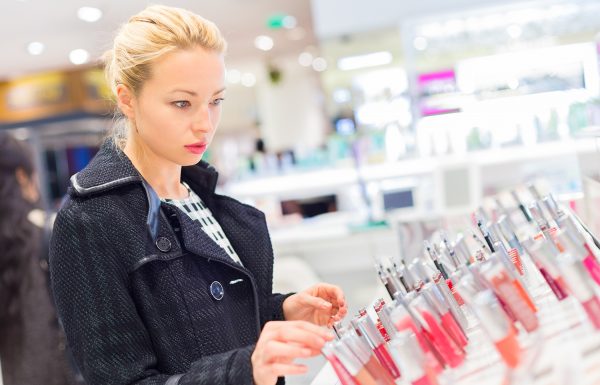
The objective of any POS display is to win the hearts and minds of customers by way of effective branding while selling more product. Successful point-of-purchase display design is the result of a careful decision-making process that combines marketing strategy, analytical thinking about customer experience and an intrinsic ability to use the visual and physical attributes of a display to forge an emotional connection with a customer—to capture their attention and stop them mid-stride.
We have written previously about how in-store signage functions as a silent salesperson, and the exact same observation can be made about point-of-sale counter displays. Arriving at a design solution for an in-store display that meets all the requirements can be challenging. There are many layers of prerequisites to be considered that influence a design aesthetic, and these aren’t always seen or understood at first glance when viewing the finished product. We’re sharing here some important, critical factors that need to be understood when embarking on creating counter display units.
Retail Destination and In-Store Environment
An understanding of the in-store retail environment that your counter display will be existing within is crucial. Will it be in a big box store such as Walmart or Target? A warehouse space like Costco or Sam’s Club? Will the space be well-lit and easy to browse like Bed Bath & Beyond? Each environment is different and comes with its own distinct set of challenges.
Before beginning the design process, it’s instructive to walk the store and watch how people interact with displays. Will the display be located on an endcap? In an aisle? Location will determine size. Will it sit at eye-level? How well-lit will it be? Will the display need to be pitched on an angle to increase visibility? How much visual clutter will surround it?
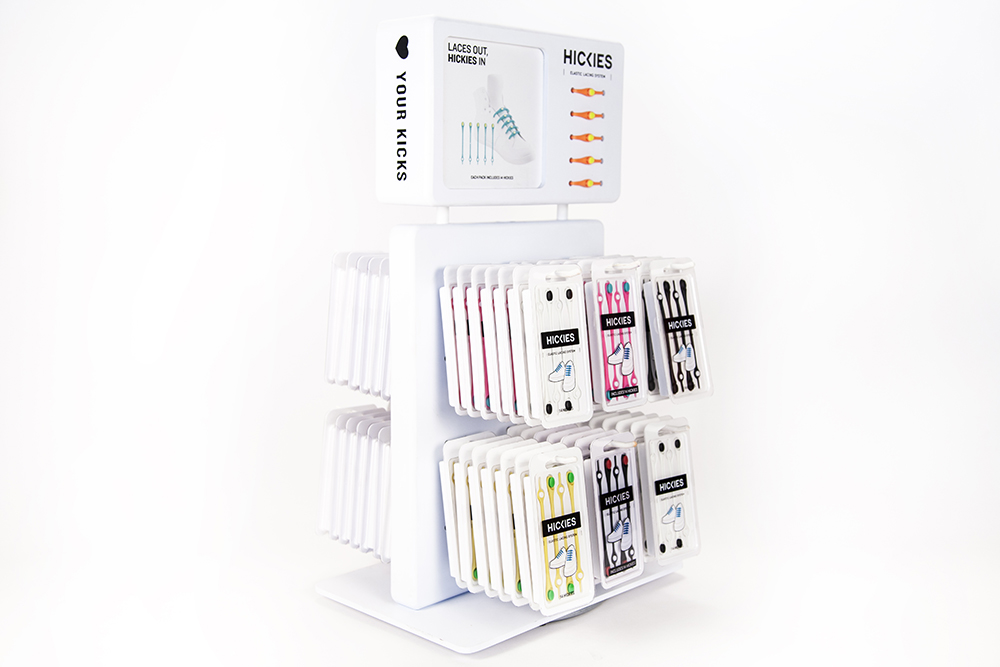
When Medallion Retail designed the Hickies magnetic shoelace counter display, its main purpose was to help introduce the new brand and innovative product to the retail market. The display was initially targeted for small chains, independent athletic and specialty retailers. But as a new brand, Hickies was allotted only a very small footprint on the cash wrap counter. Medallion maximized the footprint by creating a two-sided, rotating display that made browsing and selecting product easy for the customer. The display was situated at the cash wrap counter, advantageously sized, and perfect for impulse purchases during the checkout process.
Shelf Life, Budget and Time Frame of Counter Displays
Knowing how long your display needs to last is almost as important as knowing your client’s budget and time frame–and all three inform the materials selection process. Shelf life is segmented into the three categories of temporary, semi-permanent and permanent, which dictate the durability of the materials that will be used to produce the display.
• Temporary displays are tasked with lasting two to three months and their low per-unit cost makes them attractive for seasonal or promotional uses. Temporary displays are often intended to be switched out or replaced several times a year, and the low cost allows a retailer or brand to appear fresh and current without a big expense.
• Semi-permanent displays are built to last three months to a year, and are constructed from more durable materials. Semi-permanent displays are a better solution when customer interaction with the product or display is desired as the materials will withstand everyday use for a longer period of time.
• Permanent displays are constructed of very sturdy materials. As a greater business investment with a higher ROI than other types of displays, permanent displays should be able to withstand everyday use for one to three years. The design should be flexible enough to allow all the product to be switched out.
Temporary vs. Permanent Displays—Which One?
Both display styles offer benefits. The benefits of a temporary or semi-permanent structure will likely outweigh those of a permanent one as it will take years for the return on a permanent display to pay off.
Flexibility and Versatility of Counter Displays
Designing displays that are flexible, versatile, modular and configurable increases the utility of your displays while ensuring the best possible return on investment. The flexibility, meaning the adaptability of your design in display or signage, opens up more opportunity on the sales floor. Modular designs are the best way to meet the spatial inequities of different retail environments while also addressing different product mixes and seasonal or promotional opportunities. It’s also easier to replace parts or components in modular displays, rather than replacing complete fixtures in the event of damage or obsolescence.
Will the display be easy to set up and take down? Can the graphics or media be easily updated? Can components such as video screens, sound or additional graphics be added? Can the display be scaled and made larger or smaller depending on placement in store and available footprint?
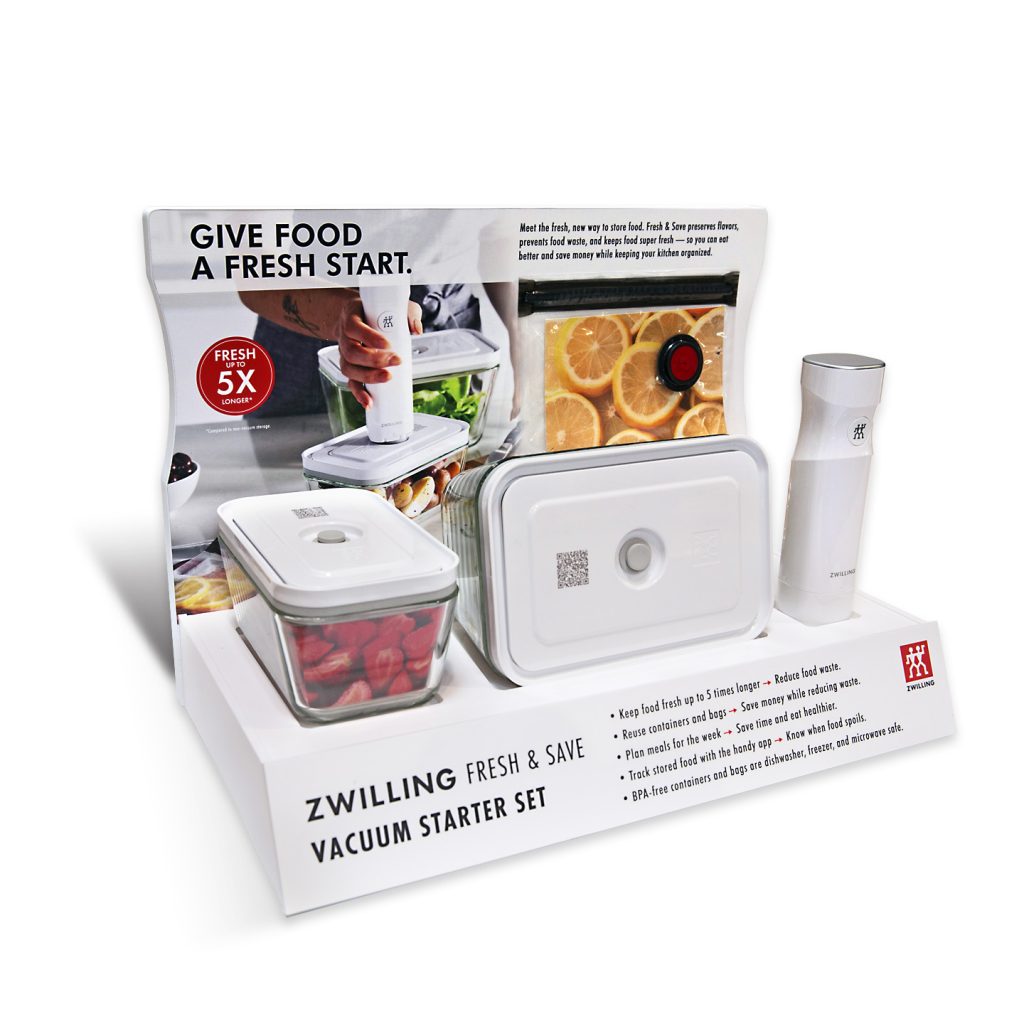
As a deeper explanation of what we mean by
flexibility, Medallion’s design for Zwilling’s Fresh & Save counter display
was originally intended for Bed Bath & Beyond and housed a screen with an
instructional video. During the last stages of the design process, Bed Bath
& Beyond eliminated the video screen due to concerns regarding Covid-19
transmission.
So Zwilling produced a new plan, this time also involving Crate and Barrel. Flexibility and modularity in Medallion’s designs for the display allowed us to consecutively create two renditions of the same design: one unit with a video screen for Crate and Barrel, and one without for Bed Bath & Beyond.
Target Customer
Make sure your client provides demographic information that includes a target customer profile and design your display and graphics to speak to that target customer. Understand who they are, what they value and what motivates them, and design around those behavioral insights. Make an emotional and conceptual connection with them by crafting a story about the brand that is both attractive and engaging. And don’t allow your customer to leave empty-handed. Be sure your messaging and communication are clear and that the customer walks away with a clear understanding of the top three product or brand insights that will sell your product.
Working with Zwilling to design their countertop display for the debut of their new product, the Fresh & Save Vacuum Storage System, Medallion understood the target audience in this lifestyle product. Those interested in healthy living, advance meal prepping and environmental consciousness would influence the look, feel and messaging of the display piece—connecting with that shopper visually and striking an immediate connection in store. Beauty may be in the eye of the beholder, but if it doesn’t resonate with the beholder, it’s just a beautiful display and one that doesn’t drive sales.
Point of Differentiation
Before beginning the design process, it is imperative to understand the points of differentiation about your client’s product or brand. Points of differentiation about a product should be identified by examining how it will be used throughout the entire lifespan with the customer, and include points of differentiation within messaging is of tremendous strategic importance.
Great point-of-purchase displays empower the shopper to quickly zero in on the key points of differentiation of a product relative to other products by clearly communicating the points of differentiation, and therefore, customer value. Differentiation becomes exceedingly important if your client’s product will be closely situated near to a competitor within a crowded in-store environment.
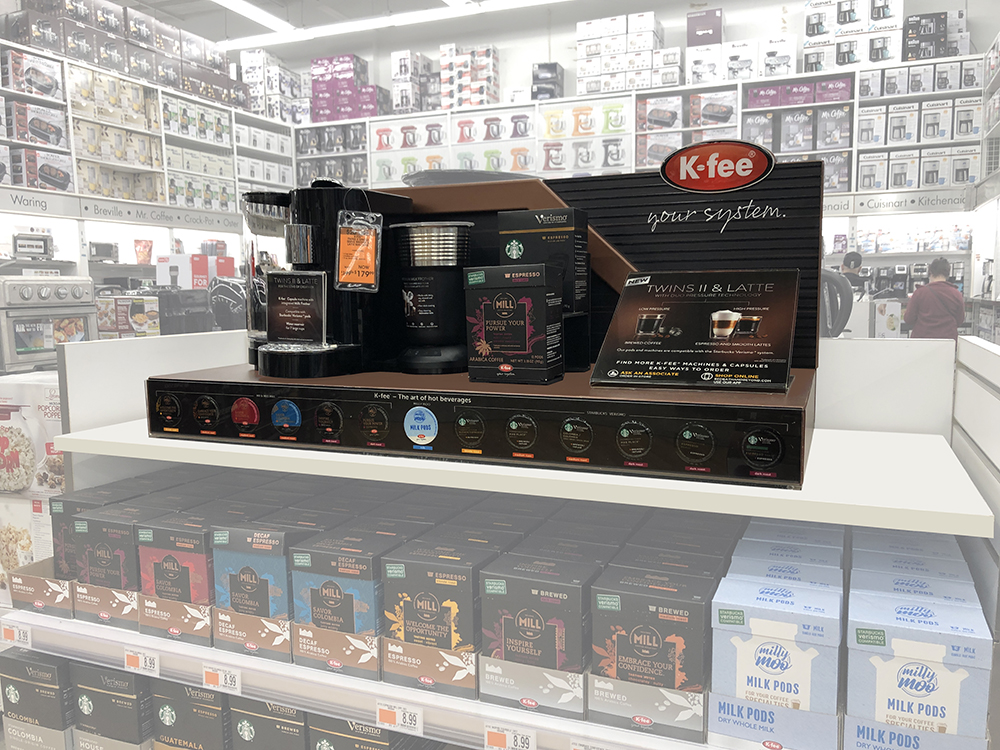
K-fee, the German coffee and espresso system company, sought Medallion’s help in designing a counter display for its first foray into the American market. The counter display was to be located on an endcap in Bed Bath & Beyond, close to its competitors Nespresso and Keurig. The main point of differentiation that the K-fee display messaging needed to communicate is that the system accepts both Mr. & Mrs. Mill and Starbucks pods, making it more convenient and more flexible than the Nespresso system. The secondary point of differentiation is the wide range of types of coffee drinks that the K-fee system makes, and the third point is the unique pressure technology that the system uses that makes barista-perfect coffee.
Medallion effectively worked all these points of differentiation into the design of the display, and when layered with the sumptuous K-fee product photography and selection of high-end materials used to design the display, the end result is one of highly effective messaging paired with a beautifully elegant look.
Customer Interaction
When a shopper can touch, feel and interact with the actual product or display, sales of product increase—and the design process becomes more complicated. Will the customer be turning on a video screen? Will they be filling out digital forms or browsing through information on a touch screen? Will they be scanning through multiple pages of product information? Will they be picking up a product to see how it turns on and off, how heavy it is, how easily it comes apart or reassembles and how it works? Will they be touching surfaces, experiencing materials and testing a product’s ergonomic properties? And what happens when there are standards that must be met? Does your design take these things in to consideration?
The Americans with Disabilities Act (ADA) requires counter displays that allow for customer interaction be situated at no higher than 36” for ease of wheelchair access. Height is not specified for displays that are not interactive, and both options can be found simultaneously within the same retail location.
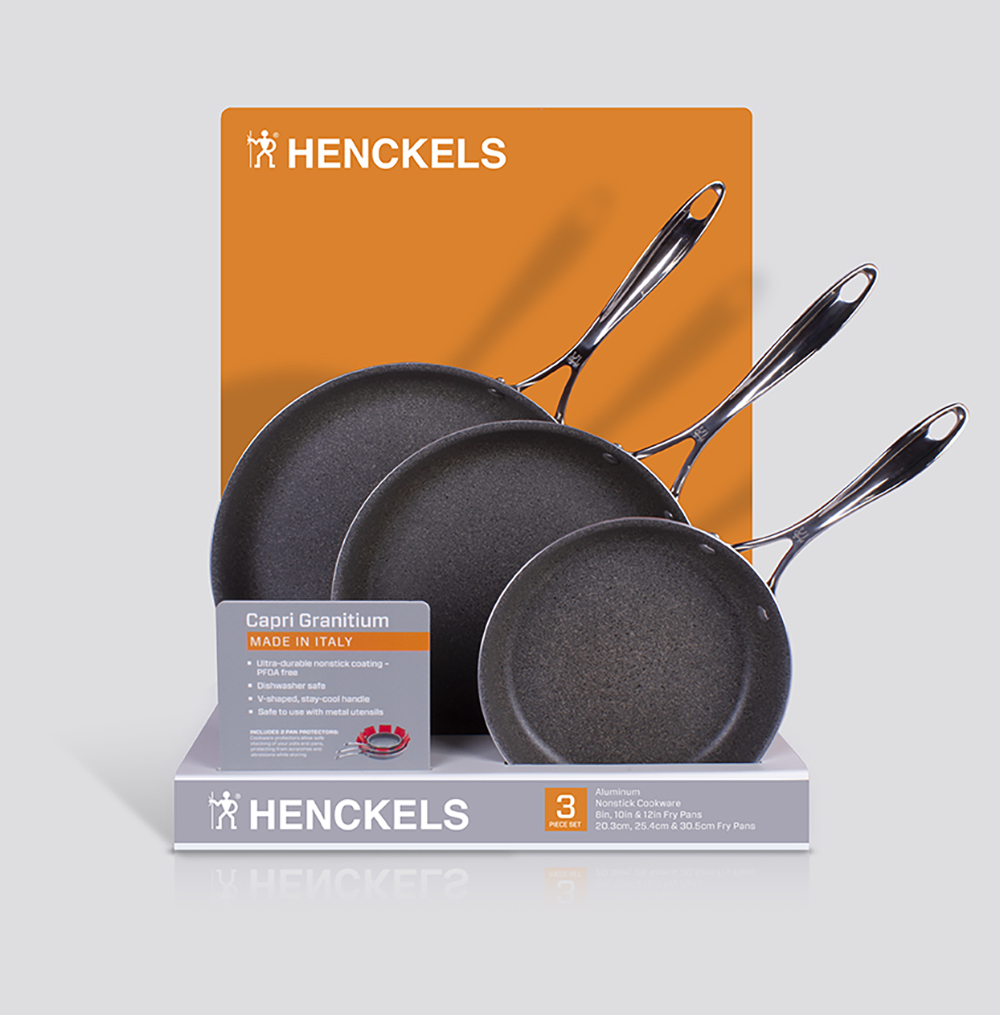
When working on the Henckels Capri Granitium Nonstick Cookware for Costco, Medallion needed to provide a design that permitted both standing customers and customers in wheelchairs to easily pick up and experience the product. The pans, a set of three in graduated sizes, rest in a groove specifically engineered to support each pan so that it stands securely on end while permitting the customer to easily select, consider and return the pan to that same groove.
Zwilling’s Fresh & Save display has several items that need to be accessible for customer interaction. The display that landed in Crate and Barrel needed to be 36” high as the video screen has a push to start feature. The vacuum food storage containers that are part of the Fresh & Save starter kit are glued into the display for security reasons, and the hand-operated Fresh & Save vacuum pump is tethered to the display to allow customers to experience how it feels in-hand.
Aesthetics
Last, but certainly not least, are aesthetics. In this age of Instagram, we know for certain that beautiful images stop people from scrolling through a feed or from making an uninterrupted beeline to a cash register at the end of a trip while shopping in store. Beautiful images are arresting and lasting and create an instant emotional connection with customers. Beautiful materials and surfaces entice customers to reach out and touch. Beauty, when in service of branding and used to appeal to a targeted audience, sells.
Medallion’s K-fee counter display is an excellent example of beauty in service of branding. Luxurious product photography and high-end materials come together to create a display that exudes sophistication and elegance, setting K-fee apart in the competitive landscape of high-end coffee systems.
Medallion Designs Counter Displays
60 years of retail experience have provided Medallion an unparalleled level of expertise in the design and manufacturing of countertop displays for many retail environments, and for an impressive list of brands and diverse products. A high-impact POP counter display starts with great design, but it’s only one part of a multi-stage journey. Call Chris Gordon @ 646.677.5618 to discuss how Medallion can design, produce and ship your next counter display program.